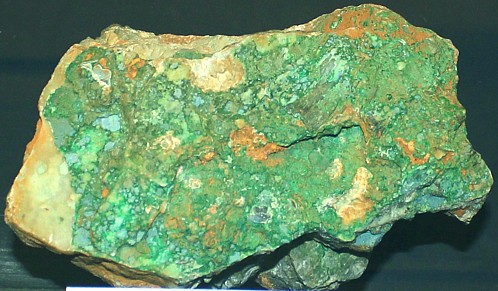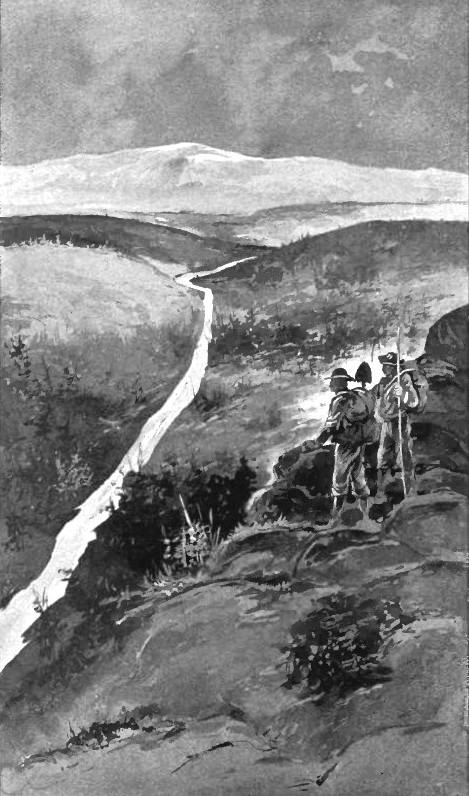Nickel, which never occurs
in its native form, is a white malleable metal, unaffected by moist or dry
air, and capable of taking a high polish. It is obtained by the reduction of
its oxide or by the "Mond" process, which consists in the formation of a
volatile nickel carbonyl produced by passing carbon monoxide over heated
nickel oxide, and the dissociation of this compound at a higher temperature
into nickel in a great state of purity and carbon monoxide, which can be
used again. The ore is usually first treated for the production of matte,
and within recent years the nickel and
copper ores of Canada have been successfully smelted for the
direct production of "monel metal," an alloy of nickel and copper, useful on
account of its acid-resisting power, is an alloy whose applications are of
increasing importance.
Nickel is used chiefly in the form of alloys. Except for deposition by
electrolysis on other metals (nickel-plating), the use of nickel in a pure
form is unimportant, but it has very extensive applications in the form of
alloys with other metals. For example, alloys of nickel, copper, and zinc
are used largely under the names of nickel silver, German silver (an alloy
of copper, nickel, and zinc in varying proportions), white metal, nickel
bronzes, etc. Nickel-copper alloys are extensively used in minting coinage.
Of these alloys, the most important are the nickel steels and
nickel-chromium steels which are used extensively because of their great
strength and toughness in bridge building, in the motor-building industry,
as well as in the manufacture of armor plate, big guns, and armor piercing
projectiles. An alloy of iron and nickel containing 36 per cent, of nickel
and 0.2 percent carbon, and known by the name of invar has a very low
coefficient of expansion. Rods made of it suffer very little change in
length for large ranges of temperature, and on that account it is useful for
making surveyor's tapes and clock pendulums. Together with nickel is an
important part of nichrome, the metal used for electric heating elements
used in hair dryers, electric ovens, soldering irons, toasters, and space
heating. Together with chromium and iron, nickel is an important constituent
of many stainless steel alloys. The manufacture of various nickel steel
alloys containing from 2.5 to as much as 35 percent nickel absorbs the
largest proportion of the nickel produced. Nickel steel has a greater
hardness and tensile strength than carbon steel, and is used for armor
plate, structural, and other purposes.
Nickel is a comparatively rare element, found often associated with chromium, native platinum or cobalt. Nickel deposits may be divided into three types similar to the cobalt deposits that is, Nickel bearing veins, nickeliferous pyrrhotines, and nickeliferous serpentine (garnierite). The minerals of nickel are Millerite, Pentlandite, Chloanthite, Gersdorffite, Niccolite, Genthite, Nickeliferous Pyrrhotite, Garnierite, Gaspeite, Kambaldaite, Zaratite and Annabergite. The mineral Annabergite occurs frequently as a green incrustation arising from the decomposition of nickel arsenides, and is on that account of some importance to prospectors as an indicator of the presence of such nickel minerals as niccolite, chloanthite, and gersdorffite. Nickel minerals are frequently found in small amounts in connection with magnesian igneous rocks, where it is commonly associated with chromite. Only a few localities produce the metal in commercial quantities, the world's output coming mostly from one of two types of deposits: 1) the nickeliferous pyrrhotite ores produced by magmatic segregation such as those of the Norlisk complex of Russia or the deposits of Sudbury, Ontario, Canada; or 2) from lateritic silicate (garnierite) nickel ores produced by deep weathering of nickel bearing ultrabasic rocks, such as those of Western Australia, New Caledonia or Riddle, Oregon. The nickel bearing vein type as noted above is not important commercially. The most important source has long been the nickel bearing pyrrhotite ores (which are associated arsenic, copper, and cobalt, and which often contains a considerable amount of silver) The Sudbury, Ontario mining district has produced many tons of ore, averaging about 3 percent nickel and 1 to 5 per cent, copper.
The nickel bearing rocks of Sudbury, Ontario are included in an elliptical area about 40 miles long and 20 miles wide. The longer axis strikes northeast. The central portion of the ellipse has been eroded to a peneplain, which is surrounded by a hilly belt of eruptive rock. The oldest series in the region consists of Huronian sedimentary rocks which are intruded by acidic and basic rocks. The Upper Huronian rocks (Animikie group) include conglomerate, tuffs, slates, and sandstones. Intruded between the Lower Huronian rocks or their igneous intrusives and the Upper Huronian sedimentary rocks is the great laccolithic mass which contains the Sudbury nickel deposits. This great sheet dips toward its center, forming a canoe-shaped body which crops out in a rudely elliptical belt having a nearly plane surface. As a result of magmatic differentiation the lower portion of the laccolith is norite and the upper portion is micro-pegmatite, the two rocks grading into each other. The different varieties of nickel ore deposits at Sudbury include (1) those formed by magmatic segregation, which occur between the norite and the underlying rocks, (2) deposits of nearly related genesis in or near dikes of norite that extend outward from the lower contact of the main laccolithic body, and (3) deposits outside the laccolith, associated with norite intrusions, which possibly are connected with the principal body of the nickeliferous igneous rock beneath the surface. The ore consists chiefly of pyrrhotite, which contains small amounts of pentlandite and chalcopyrite. At many places it grades into pyrrhotitic norite. Other minerals are pyrite, magnetite, niccolite, cassiterite, gersdorffite, polydymite, danite, galena, sperrylite, and gold. The gangue includes the rock-making minerals of norite, with some quartz, calcite, and other carbonates. Some of the deposits exhibit evidence of the presence of aqueous solutions at the time of their deposition.
The Alexo nickel deposit, in Dundonald Township, northern Ontario, is nickeliferous pyrrhotite that occurs along a contact of serpentinized peridotite and rhyolite. The origin of the ore in this case is closely similar to that at Sudbury, but the matrix is serpentine and not norite. The ore minerals are pyrrhotite, pentlandite, magnetite, and chalcopyrite. Well-formed crystals of olivine are surrounded by a matrix of pyrrhotite. Pyrrhotite veinlets cut the serpentine, and pentlandite occurs as stringers in pyrrhotite. It is believed that. Like the deposits of Sudbury, the deposit formed due to magmatic segregation.
At Lancaster Gap, Pennsylvania, pyrrhotite ores occur in amphibolite which is inclosed in mica schist. The deposits were worked for nickel before the Sudbury ores were developed. The amphibolite, which is probably an altered norite, carries pyrrhotite and chalcopyrite. Kemp considers these deposits as formed by magmatic segregation from norite.
Tests. Blowpipe reactions on nickel are poor. In the borax bead, nickel compounds give a reddish-brown color in oxidizing flame, which changes to a flecked opaque grey in the reducing flame; in the microcosmic bead the colors are reddish-browns. Nickel compounds give a feebly magnetic residue when heated on charcoal with sodium carbonate. Nickel ores oxidize on the surface to a green color, the nickel blooms, due to the formation of oxygen salts of the metal.
Return
to Metal Ores Page:
Precious and Base Metal Ores

Above: Garnierite type silicate nickel ore.

